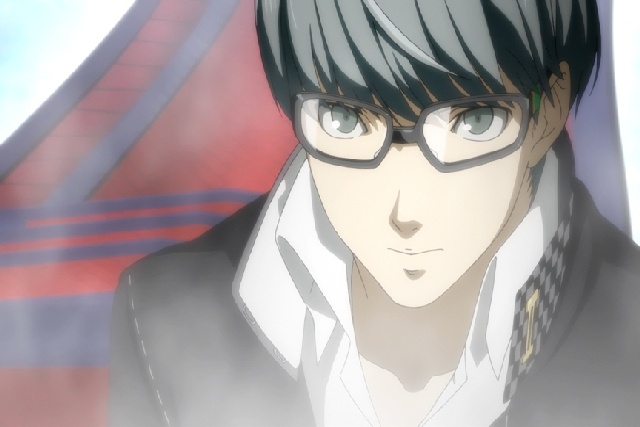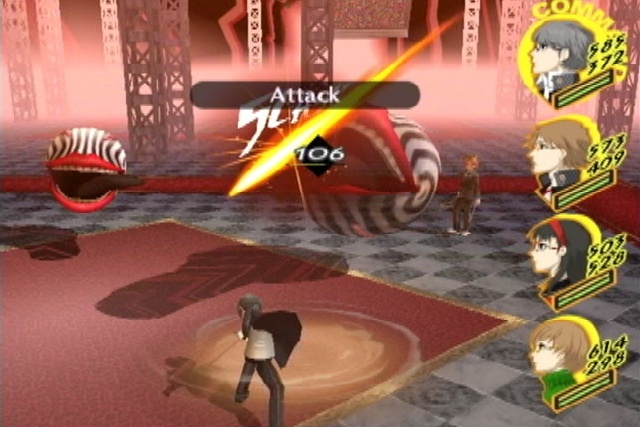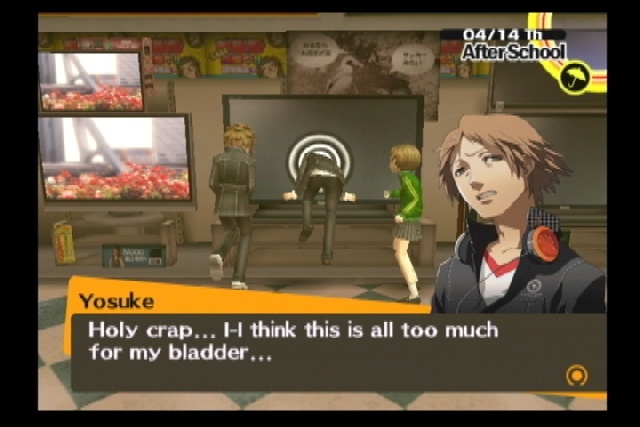Shin Megami Tensei: Persona 4 Hands-On
Atlus' flagship series continues to capture the attention of JRPG fans with its upcoming installment.
The Shin Megami Tensei fan base continues to grow as gamers eagerly await the release of Persona 4. Last year's Persona 3 (and the expanded version, Persona 3: FES) was highly praised for its eerie style, intriguing story, and gameplay, which consisted of a mix of role-playing game elements and social simulation. Developer and publisher Atlus came by our office to introduce us to the characters of Persona 4, and from what we've seen, the game follows a similar path to the last game in terms of gameplay, but there's now a stronger emphasis on story and character development. The first few hours of the game may not be as intensely compelling as Persona 3, since it's hard to top the image of someone pointing an evoker (which looks like a gun) to his head and pulling the trigger. However, Persona 4 still draws you in immediately with its unusual story. You play as the silent protagonist caught in the middle of a murder mystery that shakes up the quiet countryside town of Inaba.

Your parents have moved overseas temporarily for work , so you've been sent to live with your uncle, Ryotaro Dojima, a local overworked detective, and your adorable young cousin, Nanako. As the boy from the big city, you have no problems making new friends at school. In Persona 4, you'll spend a lot more time getting to know the people around you and watching the story develop, whereas Persona 3 started off in a bizarre sci-fi setting that immediately thrust you into the action. The excitement of battle doesn't come until a bit later, but the beginning serves as a continuous tutorial to get you up to speed. The Persona games are all stand-alone, so you don't need to have played any of the other ones to know what's going on. You'll meet Chie and Yukiko early on, two girls who befriend you out of curiosity. Chie is an outspoken girl who likes kung fu movies, and Yukiko is an introverted but popular pretty girl who works at her parent's inn. In a mildly amusing sequence, you'll meet Yosuke, a klutz who will eventually become one of your closest friends.
As your character is getting settled into his new home, a startling murder occurs, which causes quite a stir in the small town. There is a rumor floating around that if you stare into the TV at midnight on a rainy night, your soul mate will appear on screen. The problem is that each time someone appears on TV, that person ends up disappearing. You and your friends have come to the conclusion that these inexplicable disappearances are somehow tied to the weather and the mysterious midnight TV channel. So to set things right, your character uses his power to enter the TV world to save whoever is trapped in there. The strangeness doesn't end here, and it's these out-of-this-world mysteries, which the series is known for, that have garnered the attention of Japanese RPG fans.
Battles against shadows are fought in the foggy TV world, and you'll meet Teddie, a clownlike creature who helps you navigate through this foreign place. He provides you with glasses so that you can see through the fog, and he'll take notes for you when you analyze an enemy. The weather in the real world is tied to this TV world, so it's important to check the weather channel periodically for an update on the conditions. When it's foggy in the real world, the TV world will become clear and vice versa. Victims who are stuck in TV world will die when the fog clears, so you need to manage your time and save them, or else the game will end. Fights are still turn-based, and what's new with Persona 4 is that you can change your tactics to control each of your party members. Enemies can be knocked down if you can exploit their weaknesses, which will grant you an extra turn. If you decide to guard on your turn, the enemy can't get to your weakness. If all the enemies onscreen are down, you can do an "all-out" attack, where your entire party dives into the middle for a brawl, dealing extra damage. On the normal difficulty setting, the battles aren't too bad, but there are three difficulty settings before you start the game, so you can pick between easy, normal, and hard according to your comfort level.

You'll find out early on that you have the power to summon your persona (a powerful being) to fight for you. Igor will be introduced to you in an opening scene, and he's there to provide you with some guidance in terms of developing and fusing personas. A persona is explained as a facade for a character who has triumphed over his or her difficulties in life. During our meeting with Atlus, we were told that the main themes of the game are self-discovery and introspection. Once characters have faced their deepest fears, their persona will appear as a tarot card, and they'll be able to summon that persona in battle. We asked Atlus why the evoker was no longer used, and we were told that it made more sense artistically to have your persona summoned via a tarot card, considering that your persona is infused and represented by the card anyway. Personas will grow and develop abilities as you foster social links and form bonds with those around you. For example, when you form a bond with your friend Yosuke, he becomes like the secret service, and will gladly take a bullet to save you from restarting the game.
The attention to detail is impressive. Atlus was able to re-create an authentic and organic Japanese suburb, and you can fully immerse yourself in its surroundings. This town looks like something you'd see if you drove through the countryside in Japan. Usually RPGs are set in some magical far-off place, but the series has done an excellent job of keeping the environment realistic; you'll notice small details, like the clutter on the table at home or the run-down storefronts as you pass through the city streets. These nuances greatly enhance the experience considering you're spending a lot of time outside of battles, roaming the town and socializing with the locals. In Persona 4 you can take on part-time jobs to develop social links so you aren't limited to the school. If you decide to go to bed early, there is a chance you might have a dream about someone, which will increase your link with them because you are thinking about them. Although the primary subject matter is still quite disturbing and twisted, the overall feel of the game is lighter, and the characters are much more vivacious. When you're watching the fully voice anime cutscenes, it's like watching a high school drama or a sitcom because you really start to care about and grow fond of the characters.
On the music front, Shoji Meguro returns as the composer for Persona 4, and the soundtrack consists of a blend of Japanese pop and rock songs. It definitely adds to the authenticity of the setting, since the story concerns a group of high school kids and this is what you imagine they would listen to. The music is often catchy and easy to listen to, and Atlus plans to bundle in the soundtrack when you purchase the game. The voice acting is solid, and you may recognize some of the voice actors from other animes. The only voice that doesn't seem to fit well is Chie's; she sometimes sounds a bit older than she should. Nanako's voice is done very well, and she's a fascinating character that you can easily sympathize with. Since her father is always working, she attends to the household chores, like laundry and cooking, and seems quite lonely. Her voice actress conveys her youth and innocence so convincingly that you'll feel bad for her when she talks about her dad and how he's never home.

Atlus told us that it tried hard this time to address some of the issues that people had with the previous Persona. Exploring the dungeons could be repetitive and monotonous at times, and there were large story gaps between battles. In Persona 4, much more attention has been paid to keeping the story flowing, so you'll often find cutscenes or dialogue sequences as you're exploring the TV world. The world on the other side of the screen also changes so that you're not exploring the same non-descript corridors. The TV world is like a manifestation of a person's other self, so it varies each time you enter to look for a new person. Through this enigmatic place, you'll discover people's darker side and hear the horrible thoughts that they're ashamed to admit. It's incredibly interesting to watch how the characters interact and deal with their predicaments.
Persona 4 may not be on a next-generation console with flashy graphics, but its plot, characters, and gameplay are worth taking a closer look at for any RPG fan. It keeps a lot of the same elements from previous games, but from what we've managed to play, it also establishes itself as a more entertaining, in-depth, story-driven experience. We look forward to unraveling the mystery behind the TV when the game is released on December 9 for the PlayStation 2.
Got a news tip or want to contact us directly? Email news@gamespot.com
Join the conversation